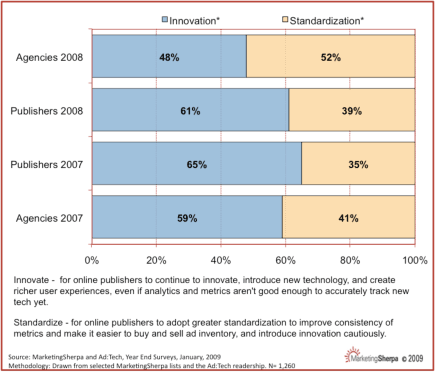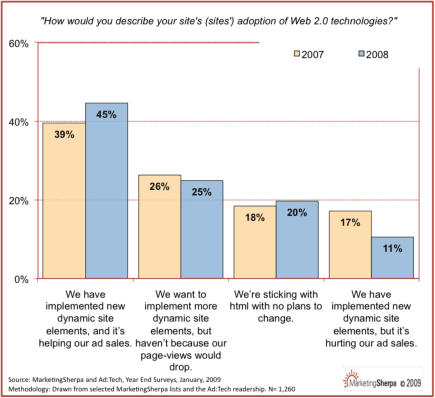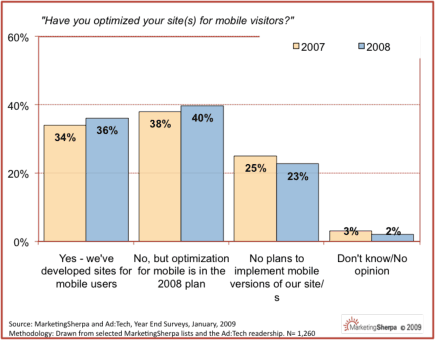Top four insights from end-of-year publisher surveyInsight #1. Innovation takes a baby step backward
More than 6 out of 10 publishers (61%) focused on innovation in 2008. But that was still a slight decrease from 2007, when 65% of publishers said their focus was innovation.
The economy definitely played a role. Marketers at publishing companies faced tighter budgets and more accountability for every dollar they spent. Innovation and new technologies that were difficult to track simply weren’t as great a priority for some companies last year.
“We were standardizing,” says Kathy Greenler Sexton, CMO, Business and Legal Reports Inc. (BLR). The company publishes analyses of state and federal laws that affect business and 400 products that help companies stay compliant with those laws. More than half of BLR’s revenue comes from online subscription services.
To boost revenue over the past year, Sexton set up a system to measure the team’s efforts by key performance indicators and dashboards that help the team understand what success on the Internet means. “Online is still the most cost-effective lead generator for us,” she says.
For BLR, 2009 will be a year for:
o Focusing on the basics
o Being manic about metrics
o Challenging all assumptions on what works and what doesn’t
o Retaining and nurturing customers
The chart also shows that agencies took an even greater step toward standardization in 2008. About 52% last year compared to 41% in 2007 said their focus was on standardization.
Focusing on standardization could reflect several scenarios, including:
o Clients pushing the ROI envelope and agencies responding by focusing on standardization to deliver those results.
o Agencies having an experience, such as confusing or bad numbers or the inability to justify spend to a client, that drove them away from innovation in 2008.
Insight #2. Publishers recognize the value of Web 2.0
Even though fewer marketers innovated in 2008, about 6% more marketers added Web 2.0 elements to their websites. The 45% of marketers who added dynamic site elements said they helped ad sales. BLR was one of them.
Online forums for HR and environmental compliance professionals were added last year, says Sexton. Adding the Web 2.0 elements, though, was more about deeper engagement with customers than ROI.
The number of marketers who said they wanted to implement a more dynamic site but didn’t for fear of decreased page views stayed pretty constant at 25%. About 26% took that stance in 2007.
NOTE: There was a pretty significant drop in the number of marketers who said they’ve implemented a dynamic site and it hurt ad sales. Only 11% of survey respondents took that stance in 2008 versus 17% in 2007.
Insight #3. Proving the worth of ad impressions tops challenges in 2008
Anyone who’s read the headlines lately knows why publishers ranked proving the worth of ad impressions the number-one challenge in 2008. Online and print ads struggle to show the ROI that other marketing tactics show –the reason advertising is commonly slashed from budgets when the economy tanks.
Online and offline ad trends were bleak throughout the year. Overall ad spending was down. Newspapers cut staff to counter revenue losses. Several magazines ceased printing or moved online.
Very targeted, niche online publishing sites seemed to do much better than traditional publishers. Take Toolbox.com, for example. The niche network of online communities geared toward IT, HR, and finance professionals did not see proving the worth of ad impressions as the number-one challenge last year.
“[It] hasn’t been much of a challenge for us because, I think, the partners that we have understand the audience they’re communicating with,” says George Krautzel, Co-founder and President, Toolbox.com.
During the past year, the company focused on improving targeting capabilities for its advertising partners. They did this by giving more flexibility with contextual targeting and deeper reach with demographic targeting.
Toolbox.com created innovative solutions for advertisers, such as a customer community program.
“We actually create communities for an advertiser,” Krautzel says. “It allows them to create awareness. If someone sees an ad or wants to connect with the vendor, it creates a place of ongoing engagement for lead nurturing or just further touch points.”
Greater challenges for Toolbox.com:
o Establishing metrics
o Working with partners to better define what they’re looking to accomplish
o Working with partners to define metrics they’re comfortable with using to measure what they’d like to accomplish
NOTE: This chart shows a significant decrease in the number of marketers that ranked implementing new site innovations, such as Web 2.0 components, as a major challenge. In 2007, it was the top challenge. Last year, it fell to third. But marketers still struggle with it.
“I think one of the challenges is that companies need to reorganize their marketing teams a bit so they have resources dedicated to actually commit to the types of campaigns they want to run,” says Krautzel.
Marketers are excited about engagement and Web 2.0, but they aren’t organized to accommodate the amount of time it takes to interact with communities in online environments.
Krautzel suggests the following: Marketing directors and CMOs who are serious about committing to Web 2.0 strategies should instruct all members of their marketing teams to engage with customers through those channels on a daily or weekly schedule.
“Marketers are being asked to participate and use these tools but they’re not thinking of the human component,” he says. “They’re thinking of it in terms of spend and technology.”
Insight #4. Mobile gets a modest boost in attention
More marketers developed sites for mobile users – about 36% in 2008 compared to 34% in 2007. But the boost was modest.
Some companies don’t see their customers using mobile devices to access the Internet or email. They can’t justify spending money to format their sites and emails for mobile users. “Our customers aren’t there yet,” says Sexton of BLR.
Other companies were simply too focused on other things. “[Mobile] wasn’t in our mix,” says Krautzel of Toolbox.com. “This year, we were optimizing our current platform and preparing our platform for new verticals.”
NOTE: About 40% of marketers surveyed said they had not optimized for mobile but they planned to do it in 2008. That’s up from 38% of marketers who took that stance in 2007.
Krautzel says he thinks the channel has “really good potential” and it’s “one for us to look at.” But no plans have been made.
Useful links related to this articleBusiness and Legal Reports Inc.:
http://www.blr.com/
Toolbox.com:
http://www.toolbox.com/












